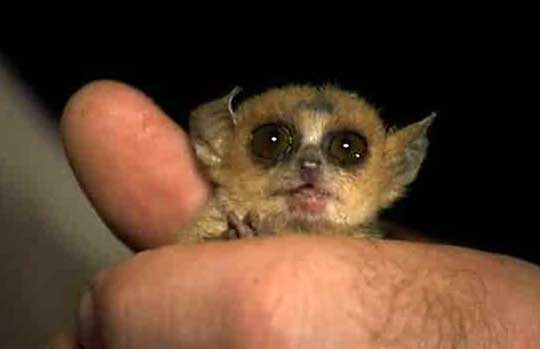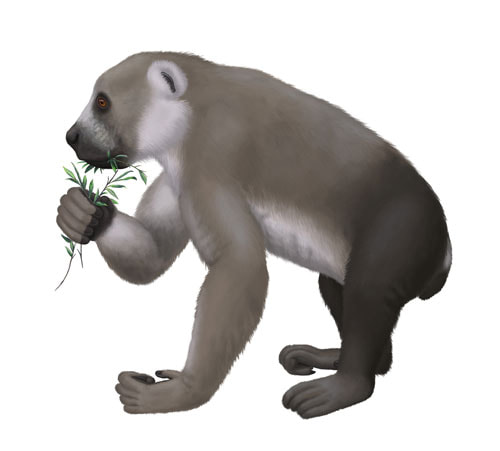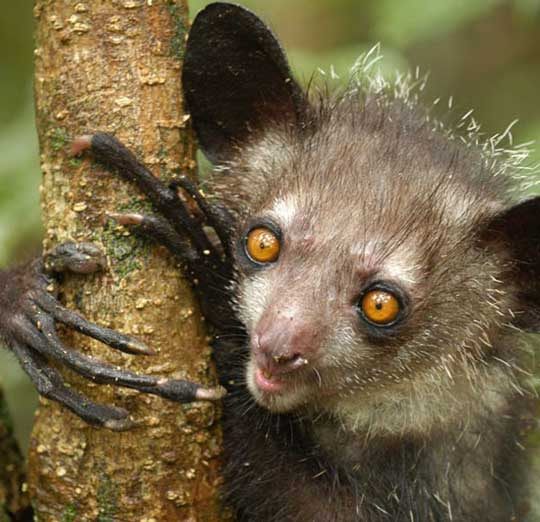|
Okay, I'm not giving out any spoilers here, but I'll say that this Awesome Animal is very relevant to the upcoming Bridgers 5. That's it. That's all I'll say about that. My lips are sealed! Lemurs. Just the name makes you think of Madagascar, doesn't it? I imagine the name makes some people think of the island country, The Republic of Madagascar. And it may make other people think of the 2005 DreamWorks picture, Madagascar. Let's take a closer look at these wide-eyed prosimian primates. What the heck is a Lemur? Lemurs are a group of about 100 species of mammals in the order Primates. Although lemurs look similar to other primates, such as the monkeys and apes, lemurs became isolated on the island of Madagascar long ago, and they evolved independently from the other primates. Lemurs typically have large eyes and are nocturnal. Most of them are arboreal (spend much of their time in trees). Below is perhaps the most recognizable of the lemurs, the ring-tailed lemur. Amazing facts about Lemurs Lemurs live only on Madagascar. The island of Madagascar broke away from eastern Africa, Antarctica, and India between 160 and 80 million years ago. But the first lemurs originated in Africa about 64 million years ago. So how did they end up on Madagascar? The most accepted explanation for this is that individuals and small populations rafted across the Mozambique Channel, the gap between Africa and Madagascar, which is about 350 miles (560 km) wide. Of course they didn't do this on purpose, but they happened to be on large, tangled mats of uprooted trees and other vegetation as the mats were washed out to sea by flooded rivers. By looking at models of ocean currents of 60 million years ago, it was determined that these rafts would have been carried to Madagascar in less than 30 days, making it possible for small mammals like lemurs to survive the trip. Now this is the important part of the story. As the continents drifted north, by about 20 million years ago the ocean currents had changed, eliminating the possibility of other animals rafting to Madagascar. This isolated the lemurs and prevented them from having to compete with other arboreal mammals such as squirrels. And even more importantly, they did not have to compete with monkeys, which appeared on Africa later. Monkeys, due to their higher intelligence and aggression, almost certainly would have wiped out the lemurs had they existed in the same place. Lemurs are diverse (over a hundred species). This is probably because of Madagascar's diverse habitats and highly seasonal climate. In fact, several species may exist in the same area of forest because they have different diets. The smallest species is the Madame Berthe’s mouse lemur, only 3.5 to 4 inches (9 to 11 cm) long, not counting the tail, and weighing only 1 ounce (30 grams): Although now extinct, the largest lemur known was the Archaeoindris. It was as large as a male gorilla, weighing about 350 pounds (159 kg). Unfortunately, these giant lemurs became extinct about 2,000 years ago. This happens to be the time at which the first humans arrived on Madagascar. As I'm sure you can guess, this is probably not a coincidence. Humans have a track record of wiping out species by over-hunting and habitat destruction. Below is the Archaeoindris. The largest living lemur is the indri lemur, which weighs about 20 pounds (9 kg). Lemurs have two tongues. Yep, you read that correctly. Lemurs have a main tongue, which isn't too different from your tongue—it is designed to help them eat (most lemurs eat fruits, flowers, and insects). But underneath the main tongue is a smaller tongue made of stiffer cartilage. This is the grooming tongue. It is used when they groom the fur of their buddies (and in the process, they can separate out a few insects for a tasty snack). This second tongue is also used as a toothbrush to clean out the hairs that get stuck between their teeth as they groom each other. In lemur society, females are dominant. Lemurs live in social groups called troops. Each troop, which could include 6 to 30 individuals, is led by a dominant female. Lemurs are not the ancestors of monkeys and apes. Lemurs are prosimians, which means they are a type of primate that evolved before monkeys and apes (simians). But remember, lemurs evolved independently while isolated on Madagascar. But that doesn't mean lemurs aren't intelligent. When it comes to understanding numbers, lemurs are as intelligent as monkeys. Check out this video on studies of lemur intelligence. One of the more bizarre species of lemurs is the aye-aye. Why? Well, mainly because of its extraordinarily long middle finger. Or more accurately, how this finger is used. The aye-aye is one of only two mammals that feed with a strategy called percussive foraging. Here's what that means: The aye-aye taps on a tree and then listens carefully to find grubs living in the wood. It then chews a small hole in the wood with its specialized, forward-slanting incisors. Finally, it inserts its long middle finger in the hole and pulls out the grubs. So the aye-aye fills the same ecological niche as a woodpecker. See the aye-aye below. Recently, the filmmaker Ceri Levy teamed up with the artist Ralph Steadman to create an entertaining book about endangered animals, titled Critical Critters. The aye-aye is one of the featured creatures. The artist Ralph Steadman has an iconic style of splattered ink, made famous by his work for Hunter S. Thompson’s gonzo book Fear and Loathing in Las Vegas. In this image, the aye-aye seems to be flashing its impressive middle finger at the world, perhaps a not-so-subtle gesture to the humans who are destroying the creature's habitat. So, lemurs deserve a place in the B.A.H.O.F. (Blastastic Animal Hall of Fame). FUN FACT: The word blastastic is simply a combining of blast (as in "that party was a blast") and fantastic (which today often means marvelous). The word blast originated before the year 1000, and it originally meant a gust of wind. But in about 1960 it was adapted to mean a party or a riotously good time. The word fantastic originated in the late 1300s, and it originally referred to elements of outlandish imagination. So, when you combine these two words, blastastic is another way to say awesome! Photo Credits:
Two Ring-tailed Lemurs - Santiago Urquijo via NewScientist Mouse Lemur - My Good Planet Archaeoindris - Wikimedia Commons Lemur running with baby - Natural World Safaris Aye-aye on tree - Ed Louis via Wired Aye-aye drawing by Ralph Steadman - Ralph Steadman
0 Comments
Leave a Reply. |
Stan's Cogitations
Everyone needs a creative outlet. That's why I write. Archives
July 2024
|







 RSS Feed
RSS Feed